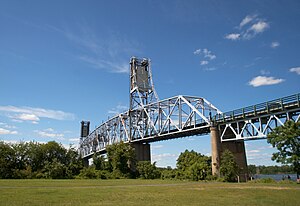Burlington-Bristol Bridge
| Burlington-Bristol Bridge | |
|---|---|

The Burlington Bristol Bridge from Burlington, NJ
|
|
| Coordinates | 40°04′53″N 74°52′10.5″W / 40.08139°N 74.869583°WCoordinates: 40°04′53″N 74°52′10.5″W / 40.08139°N 74.869583°W |
| Carries | 2 lanes of |
| Crosses | Delaware River |
| Locale | Bristol Township, Pennsylvania and Burlington, New Jersey |
| Official name | Burlington-Bristol Bridge |
| Owner | Burlington County Bridge Commission |
| Maintained by | Burlington County Bridge Commission |
| ID number | 3000002 (NJ) 097101999100010 (PA) |
| Characteristics | |
| Design | vertical lift bridge |
| Material | steel |
| Total length | 2,301 feet (701.3 m) |
| Width | 20 feet (6.1 m) |
| Longest span | 540 feet (165 m) |
| Clearance below | 61 feet when closed at high tide to 135 feet (41.1 m) when open |
| History | |
| Construction begin | April 1930 |
| Construction end | May 2, 1931 |
| Construction cost | $1.5 million |
| Opened | May 2, 1931 |
| Statistics | |
| Daily traffic | 25,241 (1992) |
| Toll | $4.00 (westbound, cash), $3.00 (E-ZPass) |
The Burlington–Bristol Bridge is a truss bridge with a lift span crossing the Delaware River from Burlington, New Jersey to Bristol Township, Pennsylvania in the United States. Construction of the bridge started on April 1, 1930, and the bridge opened to traffic on May 2, 1931. The bridge carries NJ 413 and PA 413.
The two-lane bridge has a total length of 2,301 feet (701 m), and is operated by the Burlington County Bridge Commission. The lift span is 540 feet (164.6 m) long.
The center span is lifted by the action of two large concrete slabs of slightly greater weight than the lifted span, which block traffic when fully down. They are set in downwards motion to lift the bridge by a very slight action of the motors, as gravity does the rest. Unlike most vertical lift bridges, there are no barrier gates to protect oncoming traffic, just a sign that lights up that says "STOP: BRIDGE OPENING".
A municipal garage is located underneath the rising road after the tollbooth. During times when the bridge is up for a boat passing underneath, large traffic backups are created on Keim Boulevard, the road that functions as the route to the bridge from U.S. Route 130 and Broad Street.
The tollbooths are equipped with E-ZPass and the toll as of September 15, 2015[update] — $4.00 for cars, or $3 with E-ZPass — is paid by those cars going north to the Pennsylvania side.
New bridges for the site have been proposed, but most would require the access ramp to extend out to Route 130, which would result in the destruction of historic buildings, as well as the large industrial park near the bridge.
...
Wikipedia
